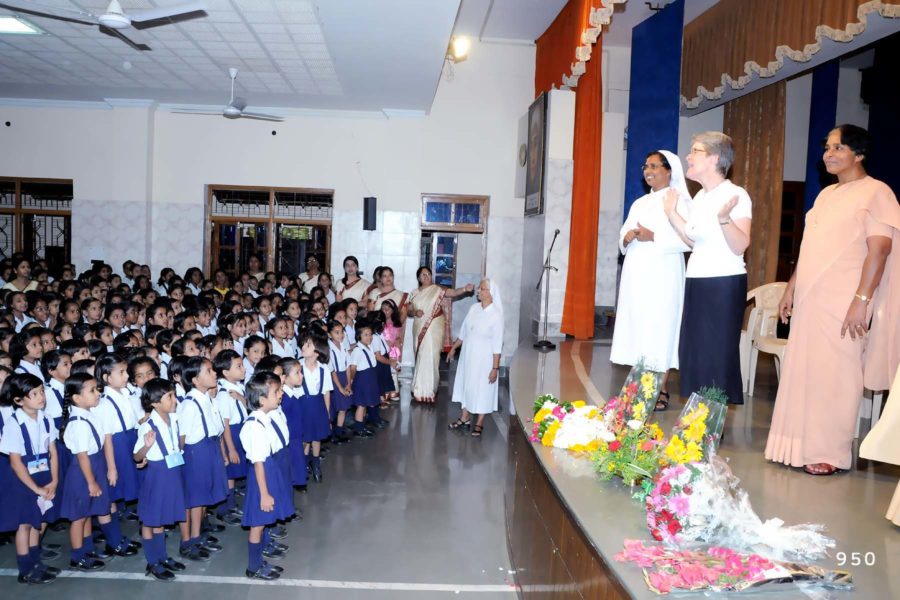6th March 2017 Holy See
International Women’s Day: Sisters are Doing it for Themselves

We usually think of the Catholic Church as a male-dominated organisation because priests staff the hierarchy. But, as I have been discovering in my first six months in Rome, women play an important role in the Church. Indeed there are nearly twice as many religious sisters (800,000) as there are Catholic priests (around 400,000) – far more than religious brothers (55,000) – and they are doing some of the Church’s most important work. Sisters are taking in victims of human trafficking and modern slavery, working with victims of rape in conflict zones, and teaching children in some of the world’s most deprived areas.
So to mark International Women’s Day on 8 March, I have met some of the religious sisters in Rome to find out what they do. Each day this week I will publish a profile of a different senior British religious sister. This blog draws out some of the common threads.
Spotting a religious sister is not easy. Many of the non-contemplative orders (that is the sisters who do not live in convents) wear ordinary, modest clothes and wear no mark of office. It is very unlikely that they will mention the senior posts they hold. You have to Google them to find out. Nor are they likely to want to tell you much about themselves – although they do speak with passion about their work. They seem to embody the humility that Pope Francis often calls for.
I asked the sisters I met for these profiles what had led them to the religious life. They all described a moment of calling, of wanting to give their lives to God. But they also all said they wanted to make a difference in the world, and at the time most of them joined (in the 60s and 70s), religious life offered far more opportunities than the other options of marriage, teaching or nursing open to women. One of the sisters thought vocations were declining in the western world because women now had many more options to make a difference and fulfil their potential than they had had 50 years ago – and that was not a bad thing.
I was struck by the orders’ focus on fulfilling potential. The sisters described how they had evaluated different orders to find the one with the right ‘charism’ (guiding idea) for them, in which they could flourish. Their training typically started with university. But most interesting was the process of finding their mission. Gone are the days of fitting bodies to jobs, regardless of talents. Now the sisters do ‘discernment’ (research, taking advice, and listening to their consciences) to identify their calling. This might be something that the order has not done before, in which case the order helps them set up new projects.
The sisters’ and the orders’ flexibility seems to be their greatest strength. Every six years or so each order’s general congregation meets to discuss and pray about what they should be doing, and elect a new leadership team. This regular process of review allows them to re-focus their activities. Many female orders started by providing education for women and girls at a time when girls were less likely to be educated than boys. Some of the orders still do that, especially in parts of the world where state education is patchy. Others, however, now work with migrants and refugees, and with victims of human trafficking and forced labour – responding to the Pope’s call to work at the peripheries of society.
The sisters’ – and brothers’- work with the most marginalised means they are doing the work that Governments often find challenging. When countries are plunged into war – as in South Sudan and the Democratic Republic of Congo – the religious orders stay, continuing to help. When trafficked women escape from their exploiters it is often because they find support in their local Church, or because the sisters take them in. For these reasons it makes sense for governments to partner with the religious orders to reach the most vulnerable.
I found my week with the sisters inspiring. I hope you will, too.
Case Study: Empowering Women and Girls through Education
Case Study: The moral dimension of work – Sr Helen Alford OP
Case Study: Fighting modern slavery – Sr Imelda Poole IBVM
Case Study: Training women leaders – Sr Christine Anderson
Case Study: The Holy Union Sisters: Bringing union and reconciliation
Case Study: Promoting dialogue with Judaism – Sr Clare Jardine
Given the prominence of the International Women’s Day, here it fell so close to the Royal Commission into the Institutional Sexual Abuse of Children. Could/would such denials of abuse be possible with women in positions of responsibility. Prominent in my mind just now is the Church’s strong denial of the equal right and responsibility of women of the Church, for the whole Church at all levels. For how much longer will there be the denial of women the right to celebrate the Eucharist – for the countless thousands of persons currently denied such access? And this while we say the Eucharist is the summit and source of our worship. Sadly, something is terribly, terribly wrong.
Dear Sally Axworthy
Thank you very much for this insightful and enlightening piece about the lives and ministries of Catholic Religious women. It is heartening to have it recognised that, in our time, women have more options to contribute to the world than were available to them 50 + years ago. And while Religious women continue to be engaged with those most in need, many of the young women that we teach in our schools are making similar contributions in today’s context. It is a good time to be alive.